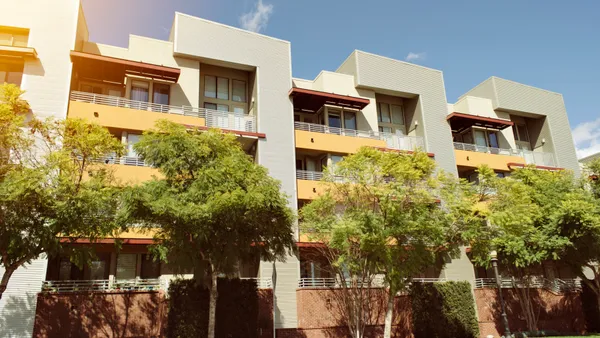Dive Brief:
- As more reports emerge about apartment properties heading to foreclosure, indicators of problems with multifamily loans continue to rise.
- Multifamily saw its distress rate jump from 3.7% in March to 7.2% in April, according to real estate data firm Cred iQ. The rate across commercial real estate rose 74 basis points to 8.35%.
- The multifamily servicing rate for commercial mortgage-backed securities loans jumped 269 basis points to 5.10%, according to a report from data firm Trepp. It last exceeded 5.00% in June 2017. However, the apartment delinquency rate ticked down 51 basis points to 1.33%.
Dive Insight:
Although the multifamily distress numbers rose significantly in April, the Parkmerced loan in San Francisco contributed to many issues.
The 3,221-unit apartment complex’s debt package includes $1.5 billion of securitized debt and $275 million of mezzanine debt. Maximus Real Estate Partners, the San Francisco-based borrower, requested the transfer into special servicing due to the property’s high vacancy rate and a looming loan maturity in December 2024, according to Morningstar.
In September 2023, Parkmerced’s occupancy rate was 83%, and its debt service coverage ratio was below break-even at 0.47x. The loan had been current, but according to information shared with Multifamily Dive from Trepp, it is now less than one month delinquent.
While Parkmerced had an outsized impact on the April numbers, the overall issues in multifamily loans go beyond that massive property and debt originated from CMBS lenders.
More issues on the horizon
In the next five years, loans on more than 58,000 properties totaling $525 billion will mature, according to a Yardi report. That is nearly half of the $1.1 trillion of loans currently backed by apartments. Through the end of 2025, loans on 6,800 properties totaling almost $150 billion are set to mature.
As interest rates have risen, loan coupons have risen 200 to 300 basis points over the past two years, according to Yardi. As that happened, multifamily property values have fallen by 20% to 30% from their 2022 peak.
When apartments are due for refinancing, they qualify for lower proceeds than they did when their existing loans were originated. That squeezes owners and even developers who want to land permanent loans for their newly built properties.
“It is getting exceedingly difficult for people to refi out of that construction financing,” Ben Kreigsman, director of acquisitions at Dallas-based real estate investment and asset management firm Lion Real Estate Group, told Multifamily Dive.
As more owners and developers face these realities, experts say distress numbers will rise in the coming months.
Click here to sign up to receive multifamily and apartment news like this article in your inbox every weekday.











